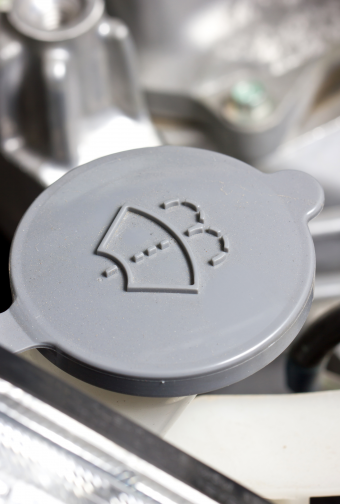What’s in Windshield Washer Fluid That Keeps It From Freezing?
 Although there are other additives that are also sometimes used for the de-icing component in windshield washer fluid, the most commonly used ingredient is methanol, which combines with water, a dash of colored ink, and occasionally some form of detergent to make up windshield washer fluid.
Although there are other additives that are also sometimes used for the de-icing component in windshield washer fluid, the most commonly used ingredient is methanol, which combines with water, a dash of colored ink, and occasionally some form of detergent to make up windshield washer fluid.
A hydrocarbon derived from natural gas, pure methanol (CH3OH) won’t freeze until temperatures drop to -143.7°F (-97.6°C); and, since it is easy to combine into a homogenous mixture with water, methanol has become a favorite de-icing additive for windshield wiper fluid.
To manage warmer winters, +20°F (-7°C) the mixture may have as little as 7% methanol, while approximately 20-25% methanol is typically added to keep the fluid in liquid form at 0°F (-18°C). Other concentrations are available to deal with harsher environments, and for a fluid that still de-ices at -25F (-32°C) a 38% solution is needed, while a 62% solution will keep the ice off of a windshield even at -50°F (-45°C).
With such a simple formula, and given the relative cheapness of methanol, some people make their own wiper fluid at home. A tricky business, methanol is a dangerous substance that should be handled very carefully. It is highly flammable, with a flash point at 52°F (11°C) and it autoignites at 867°F (464°C). To put out a methanol fire, alcohol-resistant foam and dry chemical extinguishing is recommended.
Beyond its explosive properties, it’s also highly toxic to humans. Ingesting as little as 10 mL (0.3 oz) of pure methanol can cause permanent blindness and ingesting just 30 mL may result in death, while ingesting 100 mL (3.4 ounces) almost certainly will. Other symptoms of inhaling or swallowing methanol include headache, dizziness, sleepiness, slurred speech, and blurred vision. Longer-term or repeated exposure can damage the nervous system and the liver, and may even interfere with reproduction.
The mechanism for this toxicity in humans is that methanol gets metabolized in your body into formaldehyde and then formic acid. While formic acid is readily metabolized and removed from the body, in sufficient quantities it will damage your nervous system.
If you liked this article, you might also enjoy our new popular podcast, The BrainFood Show (iTunes, Spotify, Google Play Music, Feed), as well as:
- Does Drinking Gasoline Cause You to Go Blind?
- Is the “New Car Smell” Toxic?
- What Happens When You Freeze Water in a Container So Strong the Water Can’t Expand Into Ice?
- Why Fire Hydrants Don’t Freeze and Burst During Winter
- Alcohol Does Not Help Prevent Hypothermia, It Actually Makes It More Likely
Bonus Fact:
- The first integrated windshield wiper spray cleaner was invented in the 1930s and worked more or less like they do today. Here’s the description of this little innovative device per a 1936 edition of Popular Mechanics: “Windshields can be kept clean in any weather- frosty days, muddy days, dusty days- by installing a spray cleaner that is operated by hand from the dashboard. The cleaning fluid, supplied with the unit, is mounted in its container on the steering post beneath the hood, and the pressure gun on the instrument panel sends a stream from the nozzle at the base of the windshield. This cuts the grime, frost, mud, and insects from the glass and lets the wiper clean it efficiently.”
- 1936 Popular Science
- 8 Easy Ways to Make Washer Fluid
- A Chemistry Breakthrough that Could Fuel a Revolution
- Freezing Points of Methanol
- Homemade windshield washer fluid
- Methanol economy
- Methanol economy
- MSDS
- Technical Information and Safe Handling Guide for Methanol
- Windshield De-Icer Concentrate
- Windshield Washer Fluid
- Windshield washer fluid composition
- Wiper fluid Meth/Water %
| Share the Knowledge! |
|





Hey Guys,
Just throwing the idea of a biography on Ned Kelly (Australian bush ranger) and I was also wondering why playing cards have those particular shapes/ symbols on them?
Thanks